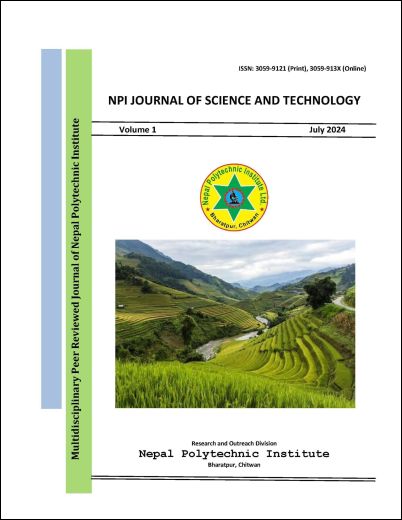Prevalence of Fasciolosis in Commercial Cattle of Tulsipur Sub-Metropolitan, Dang, Nepal
DOI:
https://doi.org/10.3126/npijst.v1i1.68943Keywords:
Fasciolosis, prevalence, cattle, fecalAbstract
Fasciolosis is a frequently occurring and economically significant parasitic disease of ruminants that is widely distributed. A cross-sectional study was conducted to find out the prevalence of fasciolosis in commercial cattle farms during the period from April 2023 to June 2023 in Tulsipur sub-metropolitan, Dang, Nepal. A total of 202 fresh fecal samples were collected purposively from the study area from cattle of different ages, breeds, sexes, and stages and examined using the direct method and the sedimentation method. The obtained data were coded and analyzed using the SPSS version 23 software. The overall prevalence of fasciolosis was 32.20%. Age-wise prevalence was found to be 52.83%, 23.46%, and 27.45% in groups less than two years, two to five years, and above five years, respectively. The prevalence of Fasciola was found to be 34.62% in cross-breed cattle and 10% in indigenous cattle, and 31.11% in females and 40.90% in male cattle. The stage-wise prevalence of Fasciola in calves, heifers and productive cattle were 50%, 39.21% and 22.52% respectively. Breed, age and stage-wise prevalence were found to be statistically significant (p<0.05) while sex-wise prevalence was found insignificant (p>0.05). Since fasciolosis is significantly prevalent among cattle in the Tulsipur sub-metropolitan area, periodic deworming is required to prevent the infections and maximize cattle production. Further study is required for the identification of the epidemiological risk factors and the preventive measures of the disease in Nepal.
Downloads
Downloads
Published
How to Cite
Issue
Section
License
All rights reserved. No part of this publication may be reproduced, distributed, or transmitted in any form or by any means, including photocopying, recording, or other electronic or mechanical methods, without the prior written permission of the publisher, except in the case of brief quotations embodied in critical reviews and certain other non-commercial uses permitted by copyright law.




